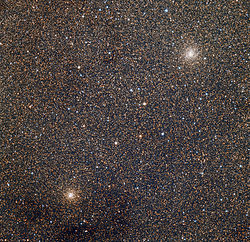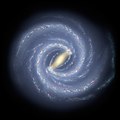

Baade's Window is an area of the sky with relatively low amounts of interstellar dust along the line of sight from Earth. This area is considered an observational "window" as the normally obscured Galactic Center of the Milky Way is visible in this direction. This makes the apparent Large Sagittarius Star Cloud visible.
Contents
It is named for astronomer Walter Baade, who first recognized its significance. This area corresponds to one of the brightest visible patches of the Milky Way. It is centered at a galactic longitude (l) of 1.02° and a galactic latitude (b) of -3.92°, [1] which corresponds to a right ascension of 18h 03m 32.14s and a declination of -30d 02m 06.96s, in the direction of the constellation Sagittarius. [2] [3]

